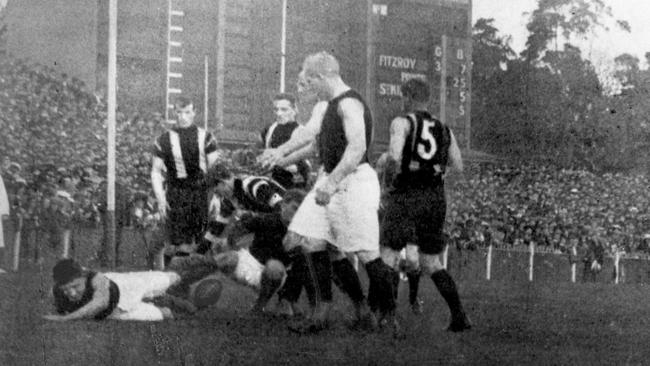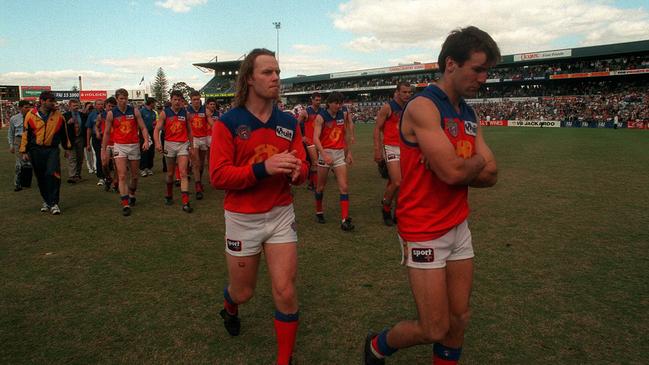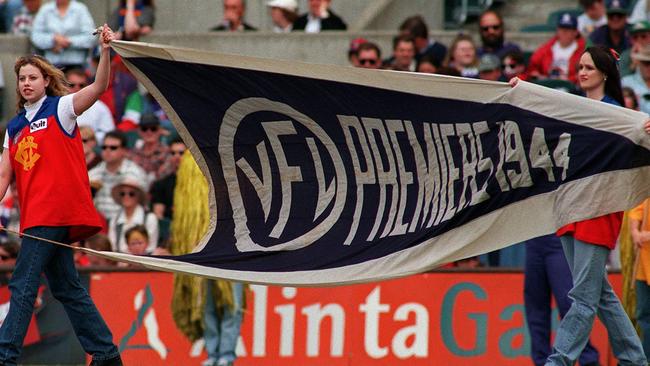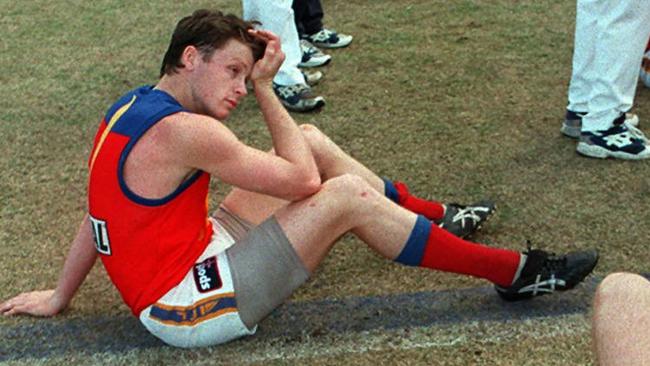Fitzroy disappeared from the AFL in 1996, but it left behind a rich history as a VFL founder
Before crippling debts broke the club and forced its move to Brisbane, Fitzroy had eight early premierships and failed to capitalise on its few modern successes. What went wrong?

VIC News
Don't miss out on the headlines from VIC News. Followed categories will be added to My News.
The end of Fitzroy as a VFL/AFL side was long, slow and painful.
But its 113-year history in the big leagues of Aussie rules football lives on through the Brisbane Lions and in the Victorian Amateur Football Association team that still bears the Fitzroy name.
ORIGINS
Apart from University, which folded when World War I broke out in 1914, only one other VFL The Fitzroy Football Club was established on September 26, 1883, at a meeting at the Brunswick Hotel that was called by local businessman George Toms and a former Fitzroy mayor, John MacMahon.
The team committee was selected and adopted a maroon guernsey and socks with blue knickerbockers and cap, and joined the Victorian Football Association the following year.
Home games were played at the Brunswick St Oval, which remained the team’s home ground for more than 80 years.
Although a strong side, ut took until 1895 for the Maroons, as they were known, to win a VFA flag.
With other VFA power sides, it left the league in 1896 to form the VFL.
GOLDEN YEARS
Fitzroy dominated the first 10 years of the VFL, playing in nine out of 10 finals series and winning four premierships including the first back-to-back wins in 1898 and 1899 and another double in 1904 and 1905.

Captain Alec Sloan and goal-kickers Jim Grace, his brother Mick and Fred Fontaine led the way in those first two flags.
The 1898 win was the league’s first true grand final. The previous year’s premiership (and those of the VFA previously) were decided by whichever team finished the season on top.
In 1904, captain Gerald Brosnan and Edgar Kneen chipped in with two goals each against Carlton, while old teammate Mick Grace booted one for the Blues. The following year, Brosnan was at the helm again with Fontaine, Lou Barker and Barclay Bailes among the best players in the winning side.
It could have been different. Fitzroy came so close to three or four wins in a row in this period — stopped by Melbourne in 1900 (by four points), Collingwood 1903 (by two points) and Carlton (in a lacklustre 49-point loss) in 1906.
Internal ructions forced some players out of Fitzroy, setting back the club.
The team switched its colours to a maroon guernsey with a blue collar and white shorts in 1911.

The Maroons became known as the Unbeatables during 1913. Despite the moniker, they lost two out of 18 home-and-away games before winning the flag against St Kilda, led by 164cm powerhouse George Shaw, who booted two goals, and captain Bill Walker.
By 1916, when Fitzroy won its next flag, 15 players had enlisted to fight in the Great War and only four teams — the Maroons, Carlton, Collingwood and Richmond could field teams.
Wally Johnson captained the team to victory over old foes Carlton, with and Thomas Heaney and Percy Parratt kicking three each for the Maroons.
1916 QUIRK
The ‘Roys had the distinction of winning both the wooden spoon and the premiership that year, coming last in the four-team home-and-away season but blitzing in the finals series.
Collingwood beat Fitzroy by 35 points for the 1917 flag but Fitzroy, by then known as the Gorillas. Had their revenge over the Magpies in 1922, winning its seventh premiership with an 11-point win over a fast-finishing Collingwood side. Jimmy Freake kicked four goals at full-forward and Percy Parratt three from the half-forward flank to deliver the win.
Fitzroy lost by 17 points to Essendon in the 1923 grand final despite another four-goal haul for Freake, the side’s last grand final appearance until 1944.
In fact, after 1924, the Maroons did not figure in the finals until 1942.
Despite their lack of on-field success, Fitzroy had a near monopoly on the Brownlow Medal for much of the 1930s.

Club legend Haydn Bunton Sr managed to win the league’s best and fairest in 1931, 1932 and 1935, with teammates Wilfred “Chicken” Smallhorn and Dinny Ryan taking the 1933 and 1936 medal respectively.
Fitzroy switched its nickname to the Gorillas in 1939 and, in 1941, added a blue FFC logo to its maroon guernsey.
The following year, Fitzroy returned to the finals. In 1943, it lost the VFL grand final to Richmond and won its eighth and last flag in 1944 with a stirring 15-point win.
Fred Hughson was captain-coach, with Keith Stackpole (father of the Test cricketer of the same name) booting two goals and Ken Sier three in a team that included future Brownlow medallist, captain and coach Allan Ruthven


The team managed brief finals appearances in 1947 and 1952 but was largely luckless in the post-war period — even with the promise shown by 16-year-old recruit Kevin Murray, who joined the Gorillas in 1955.
The FFC logo changed from blue to white in 1956, and the team ditched the Gorillas nickname for the more familiar Lions in 1957.
In 1958, the Lions bowed out early in the finals, won the 1959 night premiership and lost the preliminary final in 1960.
DARK TIMES
The Lions did not manage another finals appearance from 1960 and 1979.
The 1960s was a dark period that saw the Lions win wooden spoons in 1963, 1964 and 1966, going winless in ‘64 and ‘66.
After 1964, when the Fitzroy committee dumped him as captain-coach, Kevin Murray went west to East Perth, leading them as captain-coach them to a WAFL grand final loss to Perth, before returning to the fold in 1967 as captain under coach Bill Stephen.
Season 1966 was Fitzroy’s last at Brunswick St after lease negotiations with the Fitzroy council broke down. It shared Princes Park in 1967 and ‘68, and shifted to the Junction Oval in 1969.

Murray won the Brownlow Medal in 1969 in an otherwise dismal period for the team.
In 1970, it played Richmond in the first VFL Sunday game — a match played in the presence of Queen Elizabeth, and the same year it played Geelong in the first fixture at VFL Park.
The Lions switched to a gold logo and gold away shorts and lightened their maroon to red in 1974, Murray’s final year at the club. He was its longest serving captain, played a then-league record 333 games (including 208 losses) and won a record nine Fitzroy best-and-fairest awards.
RESURGENCE
Fitzroy gradually improved through the 1970s and with recruits including goal machine Bernie Quinlan from Footscray and Carlton premiership player Robert Walls, and established stars including Garry Wilson, 1979 was a big year for the Lions.
Round 17 saw the Lions beat Melbourne by a whopping 190 points (a VFL/AFL record to this day) 36.22 (238) to Melbourne’s 6.12 (48), then the highest winning score ever achieved in the VFL and the second highest VFL/AFL score to this day.
But Fitzroy fell in the finals race in 1979, 1981, 1983 and 1984. Quinlan shared the Brownlow with Barry Round from the Swans in 1981 and in 1983 became the first Fitzroy player to boot 100 goals.

The team shifted to Victoria Park in 1985 and in 1986 won 13 games straight to make the finals.
Costs forced the team back to Princes Park in 1987 but it was already talking about a shift to Queensland as the Brisbane Lions before a short-lived financial bailout gave Fitzroy a temporary reprieve.
By then, though, the club was in massive financial trouble, causing VFL boss Ross Oakley to attempt the failed merger of fellow cellar dwellers Footscray to form the Fitzroy Bulldogs.
Fitzroy agreed to the terms, but a rearguard action from Doggies supporters killed off the merger deal. A merger with Melbourne was also discussed.

THE AFL ERA
Fitzroy staggered into the 1990s with enormous debts and little on-field success.
A loss to Hawthorn in the 1992 night premiership gave hope that a solid playing group including Paul Roos and Alastair Lynch would lead to a revival, but they drifted away as Fitzroy’s financial woes worsened.
The team left Princes Park after 1993 and played home games at the Western Oval, using suburban grounds as its training and administration base.
The end of Fitzroy, a founding VFL club, came at the end of the 1996 AFL season, on the eve of the league’s 100th anniversary.
There was an 11th-hour proposal to keep Fitzroy in Melbourne by merging it with North Melbourne but the deal fell through. The Kangaroos were too strong on the field for the merger to succeed with the other clubs, so Brisbane and a merger with the Bears was the only other option.



The Lions’ last game was not played in front of the team’s fans in Melbourne. The side went out across the country at Subiaco Oval, playing Fremantle.
Fitzroy’s rich VFL/AFL history is preserved through the Brisbane Lions.
The Fitzroy name lives on in the Victorian Amateur Football Association, where the Lions won the premiership last season.
FITZROY
VFL/AFL Premierships: eight (the last in 1944), runners-up five times
VFL/AFL games played/won/lost/drawn: 1928 matches played, 869 won, 1034 lost, 25 drawn
Longest serving captain: Kevin Murray (157 games, 1963 to 1964, 1967 to 1972)
Longest serving coach: Bill Stephen (1955 to 1957, 1965 to 1970, 1977 to214 games, 1966 to 1976)
Longest serving player: Kevin Murray (333 games, 1955 to 1964, 1967 to 1974)
Most goals: Jack Moriarty (626 from 1924 to 1933)
Brownlow medallists: Haydn Bunton Sr (1931, 1932, 1935), Wilfred Smallhorn (1933), Dinny Ryan (1936), Allan Ruthven (1950), Kevin Murray (1969), Bernie Quinlan (1981)


